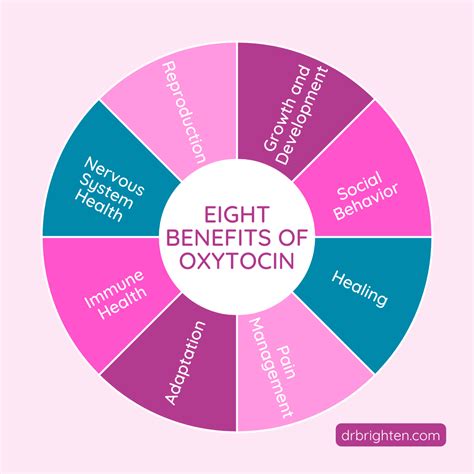Intro
Boost oxytocin levels naturally with 7 proven methods, enhancing social bonding, trust, and emotional connection, while reducing stress and anxiety through oxytocin-boosting activities and techniques.
Oxytocin, often referred to as the "love hormone," plays a crucial role in social bonding, sexual reproduction, and childbirth. Its effects on the body are multifaceted, influencing trust, relaxation, and even pain reduction. With its significance in emotional and physical well-being, understanding how to increase oxytocin levels naturally can be highly beneficial. This article delves into the importance of oxytocin, its benefits, and most importantly, explores effective ways to boost its levels in the body.
The importance of oxytocin cannot be overstated. It is involved in various physiological and psychological processes, including uterine contractions during childbirth, milk letdown during lactation, and the formation of social bonds. Oxytocin's role in trust and bonding is particularly noteworthy, as it is released during social interactions, including physical touch and sex, promoting feelings of closeness and attachment. Given its wide-ranging effects, finding natural methods to increase oxytocin levels can lead to improved relationships, reduced stress, and enhanced overall well-being.
Understanding the mechanisms behind oxytocin's release and its effects on the body is essential for appreciating the benefits of increasing its levels. Oxytocin is produced by the hypothalamus and secreted by the posterior pituitary gland. Its release is stimulated by various factors, including physical touch, social interactions, and even certain types of sensory input. By identifying and incorporating activities that stimulate oxytocin release into daily life, individuals can potentially experience a range of benefits, from stronger social connections to reduced anxiety and stress levels.
Introduction to Oxytocin Boosting Methods

Boosting oxytocin levels can be achieved through a variety of methods, ranging from physical touch and social engagement to certain dietary adjustments and mindfulness practices. The following sections will explore these methods in detail, providing insights into how they stimulate oxytocin release and contribute to improved emotional and physical health.
Physical Touch and Social Bonding

Physical touch is one of the most effective ways to increase oxytocin levels. Activities such as hugging, kissing, and sex stimulate the release of oxytocin, promoting feelings of love, trust, and bonding. Even casual touch, like holding hands or a gentle massage, can have a significant impact on oxytocin levels. Social bonding activities, including spending time with loved ones, engaging in group activities, or even petting animals, also contribute to increased oxytocin release. By prioritizing physical touch and social interaction, individuals can foster stronger, more meaningful relationships and enjoy the physiological benefits associated with elevated oxytocin levels.
Benefits of Physical Touch
The benefits of physical touch are numerous, including: - Reduced stress and anxiety - Improved mood - Enhanced sleep quality - Increased feelings of trust and bonding - Potential reduction in pain perceptionDietary Adjustments

Certain dietary adjustments can also influence oxytocin levels. Foods rich in vitamins and minerals, particularly those that support the health of the nervous system, can indirectly contribute to higher oxytocin release. For example, vitamin C, found in citrus fruits and leafy greens, supports the production of oxytocin, while magnesium, abundant in nuts, seeds, and whole grains, helps in the regulation of oxytocin receptors. Incorporating these foods into one's diet, along with maintaining a balanced and nutritious eating habit, can support overall health and potentially boost oxytocin levels.
Nutrients for Oxytocin Production
Key nutrients that support oxytocin production and function include: - Vitamin C - Magnesium - Vitamin D - Omega-3 fatty acids - Complex carbohydratesMindfulness and Relaxation Techniques

Practicing mindfulness and relaxation techniques can also stimulate oxytocin release. Activities such as meditation, deep breathing exercises, and yoga not only reduce stress and anxiety but also promote feelings of calmness and relaxation, which are conducive to oxytocin release. By incorporating these practices into daily routines, individuals can experience a range of benefits, from improved emotional regulation to enhanced social connections.
Benefits of Mindfulness
The benefits of mindfulness practices include: - Reduced stress and anxiety - Improved emotional regulation - Enhanced self-awareness - Increased feelings of calmness and relaxation - Potential increase in oxytocin levelsListening to Music

Listening to music, particularly music that evokes positive emotions or nostalgia, can stimulate oxytocin release. The emotional connection and sense of joy derived from music can foster feelings of social bonding, even when listening alone, as it often reminds us of shared experiences or special moments with others. This unique ability of music to evoke emotions and create a sense of connection makes it a valuable tool for boosting oxytocin levels and enhancing emotional well-being.
Music and Emotional Connection
The connection between music and emotions is complex, with music able to: - Evoke strong emotional responses - Create a sense of nostalgia - Enhance mood - Promote social bonding - Stimulate oxytocin releaseLaughter and Play

Engaging in playful activities and laughing with others can significantly increase oxytocin levels. Playfulness promotes a sense of togetherness and shared joy, fostering deeper social connections. Laughter, in particular, is known to reduce stress hormones and increase oxytocin, acting as a natural stress reliever and social bonding agent. Incorporating more play and laughter into daily life, whether through hobbies, games, or simply spending time with humorous and lighthearted people, can have a profound impact on emotional well-being and oxytocin levels.
Benefits of Laughter
The benefits of laughter include: - Reduced stress and anxiety - Improved mood - Enhanced social bonding - Increased oxytocin levels - Boosted immune systemAromatherapy

Certain scents, when used in aromatherapy, can influence oxytocin levels. Aromas such as vanilla, lavender, and jasmine have been shown to promote relaxation and reduce stress, conditions under which oxytocin is more likely to be released. While the direct impact of aromatherapy on oxytocin levels is still being researched, its ability to induce relaxation and improve mood makes it a potentially useful tool for enhancing emotional well-being and possibly boosting oxytocin.
Calming Scents
Scents known for their calming effects include: - Vanilla - Lavender - Jasmine - Chamomile - BergamotAs individuals explore these methods for increasing oxytocin levels, it's essential to remember that everyone's response to different stimuli can vary. What works for one person may not work for another, making it important to experiment and find the activities and practices that most effectively stimulate oxytocin release and improve overall well-being.
What is oxytocin and its role in the body?
+Oxytocin is a hormone involved in social bonding, sexual reproduction, and childbirth. It promotes feelings of love, trust, and relaxation, and its release is stimulated by physical touch, social interactions, and certain sensory inputs.
How can I naturally increase my oxytocin levels?
+Natural methods to increase oxytocin levels include physical touch, social bonding activities, dietary adjustments, mindfulness and relaxation techniques, listening to music, laughter and play, and aromatherapy.
What are the benefits of increased oxytocin levels?
+The benefits of increased oxytocin levels include reduced stress and anxiety, improved mood, enhanced social bonding, increased feelings of trust and love, and potential improvements in sleep quality and pain reduction.
In conclusion, incorporating activities and practices that stimulate oxytocin release into daily life can have a profound impact on emotional and physical well-being. By understanding the importance of oxytocin and the various methods through which its levels can be increased, individuals can take proactive steps towards fostering stronger social connections, reducing stress, and improving their overall quality of life. We invite readers to share their experiences with oxytocin-boosting activities and to explore the many ways in which this powerful hormone can enhance their lives. Whether through physical touch, mindfulness, or the joy of music and laughter, the potential for oxytocin to transform and improve our lives is vast and worthy of further exploration.
